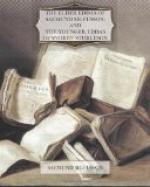The Prose, or Younger Edda, is generally ascribed to the celebrated Snorre Sturleson, who was born of a distinguished Icelandic family, in the year 1178, and after leading a turbulent and ambitious life, and being twice the supreme magistrate of the Republic, was killed A.D. 1241,[4] by three of his sons-in-law and a stepson. When Snorre was three years old, John Loptson of Oddi, the grandson of Saemund the Wise, took him into fosterage. Snorre resided at Oddi until his twentieth year, and appears to have received an excellent education from his foster father, who was one of the most learned men of that period. How far he may have made use of the manuscripts of Saemund and Ari, which were preserved at Oddi, it is impossible to say, neither do we know the precise contents of these manuscripts; but it is highly probable that the most important parts of the work, now known under the title of “The Prose Edda,” formed a part of them, and that Snorre—who may be regarded as the Scandinavian Euhemerus—merely added a few chapters, in order to render the mythology more conformable to the erroneous notions he appears to have entertained respecting its signification. Be this as it may, the Prose Edda, in its present form, dates from the thirteenth century, and consists of—1. Formali (Fore discourse); or the prologue. 2. Gylfa-ginning (The deluding of Gylfi). 3. Braga-roedur (Conversations of Bragi). 4. Eptirmali (After discourse); or Epilogue. The Prologue and Epilogue were probably written by Snorre himself, and are nothing more than an absurd syncretism of Hebrew, Greek, Roman, and Scandinavian myths and legends, in which Noah, Priam, Odin, Hector, Thor, AEneas, &c, are jumbled together much in the same manner as in the romances of the Middle Ages. These dissertations, utterly worthless in themselves, have obviously nothing in common with the so-called “Prose Edda,” the first part of which, containing fifty-three chapters, forms a complete synopsis of Scandinavian mythology, derived principally from the Poetical Edda.
THE TRANSLATOR.
FOOTNOTES:
[Footnote 1: The following, the first among many, may serve as a specimen.
Saemund was residing, in the south of Europe, with a famous Master, by whom he was instructed in every kind of lore; while, on the other hand, he forgot (apparently through intense study) all that he had previously learned, even to his own name; so that when the holy man John Ogmundson came to his abode, he told him that his name was Koll; but on John insisting that he was no other than Saemund Sigfusson, born at Oddi in Iceland, and relating to him many particulars regarding himself, he at length became conscious of his own identity, and resolved to flee from the place with his kinsman. For the purpose of deceiving the master, John continued some time in the place, and often came to visit him and Saemund; till at last,




